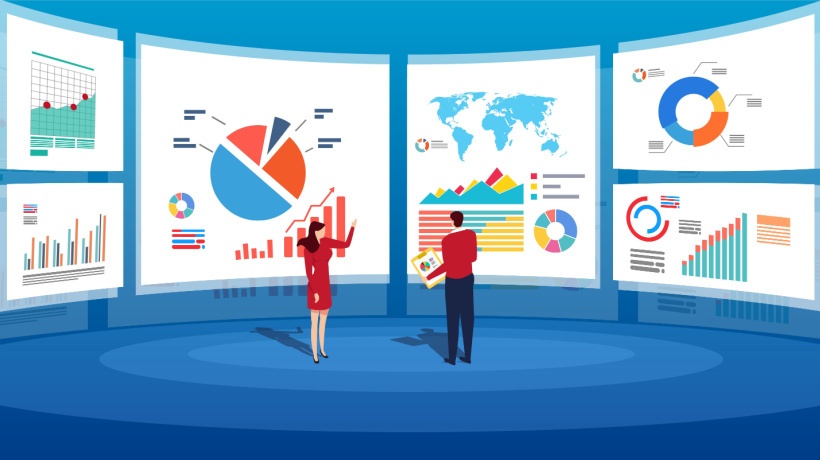ATD ICE L&D Conference Debrief
ATD International Conference and Expo is one of the biggest L&D conferences with over 8000 participants, hundreds of sessions, 300-something vendors, 4 days, and pretty long lines. It was also the eightieth anniversary of ATD. Fast and furious. I'm not even talking about the wi-fi. It was overwhelming and invigorating at the same time, like the poor person whose phone number might have been 867-5309 in the 1980s.
Absolutely confused by this intro? You're not alone. Natural Language Processing (NLP) analysis of the introduction says it may sound "confused, assertive, and disapproving" to readers.
The previous sentences intentionally include data. Both quantitative and qualitative. But data (like hips) can confuse people, or even lie! Well, not exactly; it's not the data that confuses or lies but how you use it, and that's one of the takeaways below. We'll get to that in a second.
Takeaway #1: AI Here, AI There
Of course, Artificial Intelligence (AI) was everywhere. So much so that I assumed Assessment International was about Artificial Intelligence as well, on the Expo floor. Most applications of AI seemed to be supporting a) faster development of content, b) easier avatar or text-to-video creation, c) digital coaching (smart bots), and d) adaptive course recommendations (don't get me started on this).
Is AI Going To Change How We Do L&D?
Is AI going to change how we work? No. It already has. But right now, it feels like getting into a self-driving car on the highway. Suddenly, you realize you can do a lot of things while not focusing on driving: clap your hands, read, close your eyes, take a nap, live stream, do your makeup, complete your mandatory ethics training, etc. Meanwhile, you still have no idea how self-driving cars work, where you're going, or what problem it is solving for in the first place.
We have a solution. We're figuring out what problems it could be used for. I'm sure your feed is filled with AI prompts, seven-figure prompt engineer promises, and a future of learning. The number of AI experts in the L&D field has clearly suppressed the previous microlearning gurus and virtual learning ninjas. Can we tell the future? Sure. But data, like hips, can be confusing. The challenge is that we're making long-term projections based on short-term perceptions.
First, it's good to experiment with AI. We should take it for a test drive for sure. But, at the same time, don't forget your destination before you take your hands off the wheel! Be clear about what you're solving for. For example, if you're excited about AI speeding up content creation for your courses, you're solving an efficiency problem. Just like with rapid authoring decades ago, you're not going to make learning more effective, you're going to create more ineffective content faster. Think of AI as new ways to work, rather than just how to use it to incrementally improve your current tasks. Finally, be aware of "hallucinations" that read as convincingly true but are, in fact, totally made up, as the lawyers who submitted bogus cases to the court found out.
Video Tools Use Cases
Video tools like Colossyan, Sythesia, and D-ID can now produce amazing results from text-to-video avatars. Translation time can be cut dramatically. That most dreaded request by SMEs and stakeholders, the late script change, is no longer a barrier. But again, be sure about the problem you're solving for! If you just want to "spice up" boring content by letting an AI avatar talk, you might just be prolonging the past with the illusion of stepping into the future.
Once we had an efficiency problem with PowerPoint content. We literally couldn't create content fast enough. So I built a VBA script that read an external file with the content and built the PowerPoint content on the fly based on the template. I solved the efficiency problem. I wish I had had the experience back then to question the approach, rather than jumping in with an "innovative" solution.
Takeaway #2: Data. Data. Data.
Based on LinkedIn feeds, L&D may seem to be an industry with lots of theories and opinions. The fact that we still post about learning myths and ignore the validity of personality tests, let alone use them for serious workplace decisions, illustrates the problem. While this works in L&D circles, the business cares about results. So, "showing the value" is about showing impact, not talking about the importance of learning. And to do that, you need data.
I was happy to see a lot more interest in data, data literacy, analytics, and measurement this year. Will Thalheimer introduced his performance-focused smile sheets along with the Learning Transfer Evaluation Model (LTEM) that our team is also using [1]. I also had a great conversation with Patti Phillips (ROI Institute) on some of the challenges L&D has with data.
Vanity Mirrors Block Your View Of The Road Ahead
This may be different in your organization, but in my 20+ years in corporate workplace learning, the business didn't really care about how many courses were delivered, how much time people spent in training, how many completions a course had... At this point, I usually get some defensive reactions, such as: "That's not true! They do care about our data! We had to build reports and dashboards for them!" Beyond legal requirements on compliance (again, don't get me started on compliance as butts in seats), here are some questions to ponder:
- What business decisions were made based on the learning data?
- What actionable insights did your data provide for managers or business leaders through proactive analytics?
- Besides you and your intern, how many unique users were regularly checking out the dashboard?
- How did you make sure the business understands that "passing a knowledge check" does not mean people "know what to do" on the job?
Three main problems (there are a lot more) we need to solve in the L&D industry are:
- Give up control
Learning is an individual process; application on the job is most likely to happen in a team context. Neither of them is controlled or "driven" by L&D. Training is an event that can accelerate learning under properly designed conditions. So, focus on the conditions and context. Not every problem is a learning problem and especially not a training problem. Think of learning as a shared responsibility. We all need to do our job. L&D does not own learning. - Go beyond courses and content
We've been saying this for decades ("L&D is at a turning point"), but with AI, the timeline has been exponentially accelerated. We need to decide if we are responsible for creating and maintaining course content (handling stuff in the LMS), or supporting people doing their job. If the latter, we need to get out of the training sandbox and theoretical skills development for feel-good learner personas. - Speak the language of data
One thing I guarantee, nobody in the business cares about the list of well-written learning objectives or Bloom's verbs. We need to speak data, the language of information. It starts with data literacy so everyone is on the same page with the fundamentals. You may not be a data analyst, engineer, scientist, etc. But you need to work with them.
Professionals working with data are well-versed in statistics and data modeling. They are not learning experts or domain experts. They can give you answers with confidence based on the data, but their job is not to be creative or innovative. You need to bring that to the table with the right questions.
But AI! Why bother with human data, folks, when you have ChatGPT? This reminds me of my early days working for the Peace Corps as a Hungarian language and culture teacher. In week one, one of the volunteers asked me to teach them how to ask "Where is the post office?" in Hungarian. I said I can surely teach you that, but what if they answer your question?
Back to ChatGTP. Asking is the easy part. However, you also need to have fundamental data literacy to interpret and validate the answer. Use the tool to your advantage instead of letting it take advantage of you.
Takeaway #3: My Own Session: Data Literacy Fundamentals For Learning
A handful of hands (n=250) went up when I asked who here was excited about working with data. The majority of the participants were interested in how to start thinking differently about data but not in "crunching" it. That's why I designed the session around what data literacy is about: arguing with data in context. Rather than learning about data literacy, they were practicing it through problem-solving. I also added gamification elements (mystery, cards, surprise, challenge, humor, etc.) just enough for it to feel like a game (it wasn't, by the way). Apparently, it was successful enough for participants to ask if they could get my data literacy "gameboard" with the cards. If you're interested in data literacy and how I designed the interactive session, read these articles for the details.
Takeaway #4: Humor
Did you know where the word "humor" comes from?
The term derives from the humoral medicine of the ancient Greeks, which taught that the balance of fluids in the human body, known as "humours", controlled human health and emotion.
Controlling human health and emotions! Sounds like a well-being app :) Humor provokes laughter and evokes emotions. It is a sort of amusement. The conference keynote, Adam Grant, used it in his opening speech when showing some "mean tweets"-style videos. Speakers used humor throughout their presentations. And if you know me, you know there was no shortage of targeted humor in my session.
Just like with learning, you do not own or control humor. It is a personal reaction. You have to know your audience to make it work. When it works though, it can make the experience memorable. Therefore, use it sporadically, and target the main talking points. I like to think of it as the difference between telling and sharing. Telling a joke means you are delivering something that makes the audience laugh. Sharing is more personal and involves both the audience and the person sharing the experience. Storytelling with data using humor should be more of a story-sharing. Inviting people into a world you open up to, rather than just providing instructions on how to do something.
Telling can be transactional. I'm here to entertain you with a joke. Sharing is more of a dialogue, the art of actively listening and reacting. Sharing sends a message that you believe there is value in what you offer to the audience. If you're an aspiring speaker, I suggest exploring the difference between telling and sharing. While the end results may seem to be the same, the experience people take away can be very different. Speaking of sharing...
Takeaway #5: Sharing Stories
Stories are powerful. They involve emotions, which makes them not only more memorable than pure data, but also, more likely actionable. In fact, some say we keep telling stories to ourselves as we're navigating the world. Your stories feed your thoughts, your thoughts feed your stories. The stories you're telling about yourself to yourself can determine your beliefs, and behaviors, and affect relationships.
These are exciting times for those working in the digital world already. The Expo was buzzing with new features, inspiring thousands of L&D professionals to take this year's slogan seriously: "Together We Build a World that Works Better."
Two things: a) always define better!; and b) while we're building this better world, let's not forget about the digital divide! Let's keep in mind that not everyone can afford or has access to this bright digital future!
References:
[1] Thalheimer, Will. 2022. Performance-Focused Learner Surveys: Using Distinctive Questioning to Get Actionable Data and Guide Learning Effectiveness. 2nd Edition. Somerville, MA.: Work-Learning Press.









